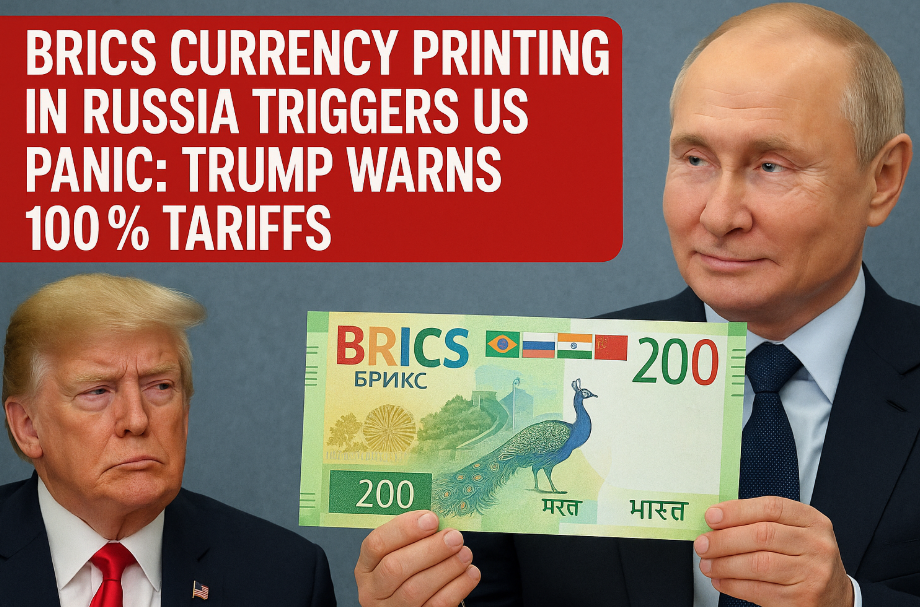
In a move that’s sending shockwaves through Washington, Russia has officially started printing BRICS currency banknotes, escalating tensions with the United States. According to Sergei Katyrin, President of the Russian Chamber of Commerce and Industry, 10,000 units of a commemorative BRICS banknote have been printed by a premier Russian security printing house.
The idea behind the BRICS “momento” note emerged from the desire among the business community to create a visual and conceptual representation of BRICS unity and its strategic partnership principles. The banknote is symbolic, but its implications are far from trivial.
This development comes at a time when US President Donald Trump has raised the rhetoric on tariffs and economic pressure. Trump has already threatened a 100% tariff on Russia if the Ukraine war does not come to an end within 50 days. In a public interaction with NATO Secretary-General Mark Rutte, Trump warned of extreme measures if Russia fails to reach a peace agreement. He further threatened secondary sanctions on nations continuing trade with Russia — clearly pointing at India and China, two major BRICS economies.
Despite Western sanctions and pressure, countries like India and China have continued their trade relationships with Russia, openly defying US diktats. This, in Trump’s eyes, justifies increased economic pressure on the entire BRICS bloc.
Further escalating matters is the symbolic printing of BRICS currency, which features national elements from founding member countries. The banknote showcases:
The flags of the founding BRICS nations
Names of countries written in their native languages
India’s national bird, the peacock, along with the Indian flag and “भारत” written in Hindi
These symbolic banknotes have appeared in denominations of 100 and 200.
But what’s driving BRICS toward its own currency?
The main reason is to counterbalance the political power of the US dollar. For decades, the dollar has been used as a tool for sanctions and political coercion. Countries like Russia, Iran, and Venezuela have experienced firsthand how exclusion from dollar-based systems can paralyze an economy. BRICS nations now want to protect themselves from such vulnerabilities.
Another important goal is to promote trade in local currencies among BRICS members. This would eliminate exchange rate risks, reduce dependence on volatile dollar fluctuations, and make trade more stable, cheaper, and efficient.
Moreover, BRICS nations want to reduce their economic exposure to the dollar. Most of their currencies are weaker than the dollar, leading to higher import costs and inflation. By reducing dollar dependency, they can avoid such inflationary shocks and external pressure.
BRICS is also working to challenge the unipolar financial system dominated by the West, particularly institutions like the IMF and World Bank. The idea is to build an independent financial ecosystem, complete with:
A trusted payment system
Possibly a shared digital currency
CBDCs (Central Bank Digital Currencies) from member nations
Localized settlement frameworks for cross-border trade
At last year’s St. Petersburg International Economic Forum, a 200-unit symbolic banknote was displayed, followed by another one this year featuring President Vladimir Putin holding the note. These carefully timed symbolic moves are a clear sign that BRICS is building momentum toward its long-term goals.
However, the path forward is complex. The BRICS bloc includes nations with vastly different economic foundations:
Brazil: agriculture and minerals
Russia: energy-based economy, under sanctions
India: services and industrial base, with relative currency stability
China: export-based economy with tight currency control
South Africa: a mixed economy
Creating a common and stable currency that can cater to such diverse economic frameworks is a huge challenge. But the vision remains intact — to eventually build a new financial world order where the dollar is not the only currency in power.
Naturally, this prospect has deeply unsettled the United States. Trump’s repeated threats, his impatience over the Ukraine war, and his explicit warning of new tariffs are clear signs that Washington views the BRICS monetary initiative as a direct challenge to its global influence.
Though no official BRICS announcement regarding the launch of a common currency has been made, Trump appears convinced that such a development is inevitable. His statements suggest that even the possibility of a BRICS currency is enough to trigger economic countermeasures from the United States.
As Russia presses ahead with the symbolic printing of banknotes and BRICS continues to explore alternatives to the dollar, global financial power dynamics are shifting rapidly. The coming months may prove decisive in shaping the future of currency and trade.
Disclaimer:
This article is based entirely on provided source material. It does not represent financial advice or independent verification. The views presented are for informational and editorial purposes only.




